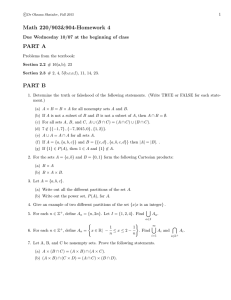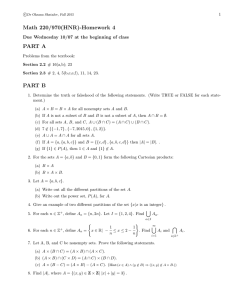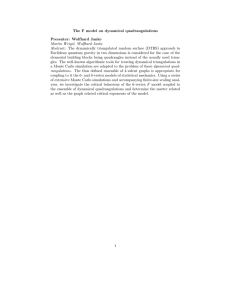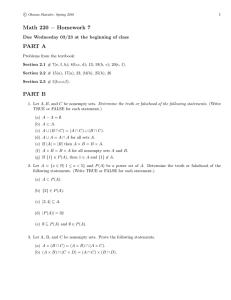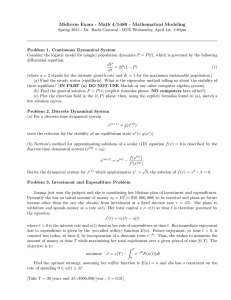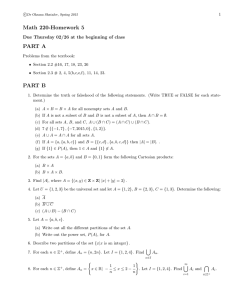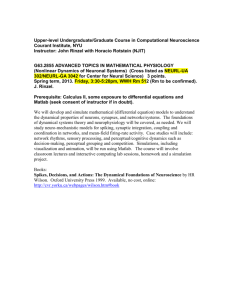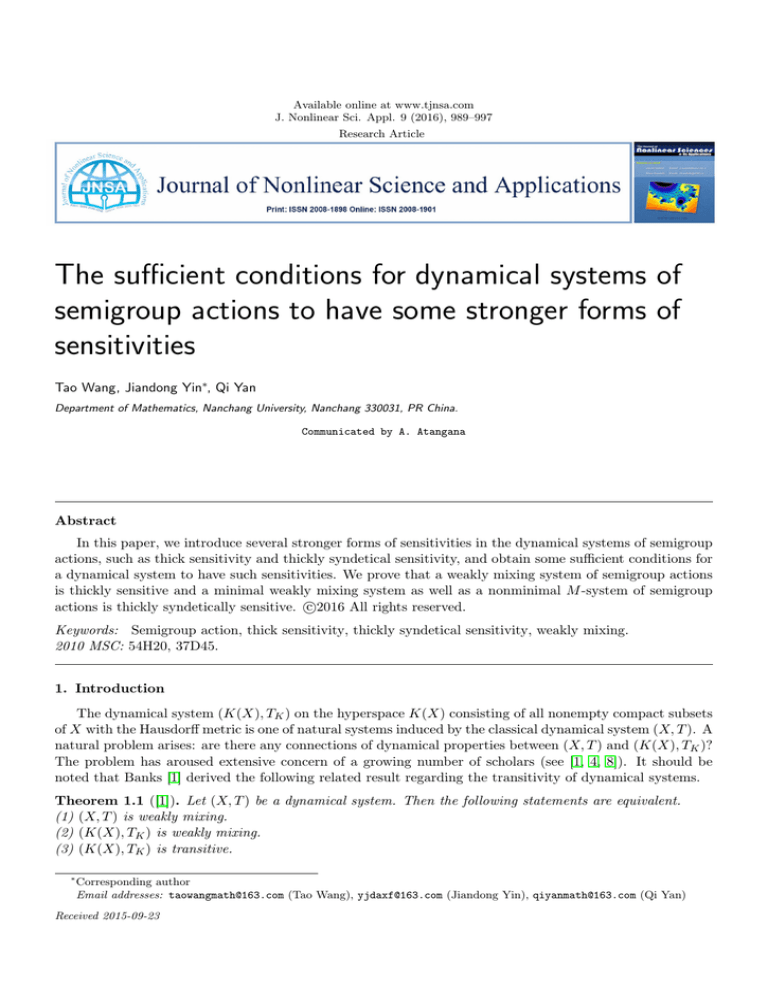
Available online at www.tjnsa.com
J. Nonlinear Sci. Appl. 9 (2016), 989–997
Research Article
The sufficient conditions for dynamical systems of
semigroup actions to have some stronger forms of
sensitivities
Tao Wang, Jiandong Yin∗, Qi Yan
Department of Mathematics, Nanchang University, Nanchang 330031, PR China.
Communicated by A. Atangana
Abstract
In this paper, we introduce several stronger forms of sensitivities in the dynamical systems of semigroup
actions, such as thick sensitivity and thickly syndetical sensitivity, and obtain some sufficient conditions for
a dynamical system to have such sensitivities. We prove that a weakly mixing system of semigroup actions
is thickly sensitive and a minimal weakly mixing system as well as a nonminimal M -system of semigroup
c
actions is thickly syndetically sensitive. 2016
All rights reserved.
Keywords: Semigroup action, thick sensitivity, thickly syndetical sensitivity, weakly mixing.
2010 MSC: 54H20, 37D45.
1. Introduction
The dynamical system (K(X), TK ) on the hyperspace K(X) consisting of all nonempty compact subsets
of X with the Hausdorff metric is one of natural systems induced by the classical dynamical system (X, T ). A
natural problem arises: are there any connections of dynamical properties between (X, T ) and (K(X), TK )?
The problem has aroused extensive concern of a growing number of scholars (see [1, 4, 8]). It should be
noted that Banks [1] derived the following related result regarding the transitivity of dynamical systems.
Theorem 1.1 ([1]). Let (X, T ) be a dynamical system. Then the following statements are equivalent.
(1) (X, T ) is weakly mixing.
(2) (K(X), TK ) is weakly mixing.
(3) (K(X), TK ) is transitive.
∗
Corresponding author
Email addresses: taowangmath@163.com (Tao Wang), yjdaxf@163.com (Jiandong Yin), qiyanmath@163.com (Qi Yan)
Received 2015-09-23
T. Wang, J. D. Yin, Q. Yan, J. Nonlinear Sci. Appl. 9 (2016), 989–997
990
In 2014, Liu and Wang [5] introduced some stronger versions of sensitivities, including thick sensitivity
and thickly syndetical sensitivity. Besides, some sufficient conditions for a dynamical system to have these
sensitivities were obtained. Naturally, one will ask whether the result of Theorem 1.1 remains true in
the setting of dynamical systems of semigroup actions. In Section 3, we give an affirmative answer to
this problem (see Theorem 3.9). Then for the dynamical systems of semigroup actions, we introduce several
stronger forms of sensitivities in Section 4, such as thick sensitivity and thickly syndetical sensitivity. Besides,
by Theorem 3.9, we present some sufficient conditions for a dynamical system of semigroup actions to have
these sensitivities (see Theorem 4.10– 4.13). The gotten results in this article generalize the corresponding
results of [5]. Furthermore, as a byproduct of this article, we show that if both of two dynamical systems of
semigroup actions are syndetically transitive and weakly mixing, then the product system of them is also
syndetically transitive and weakly mixing.
2. Preliminaries
Throughout the paper, by a dynamical system we mean a triple (S, X, π), where X is a compact metric
space with the metric d and S is a semigroup which acts on X, such that the action
π : S × X → X, (s, x) → sx
is continuous. Then t(sx) = t(sx) for all x ∈ X and t, s ∈ S and the map X → X, x → sx is continuous. Just
as Ellis [2] had mentioned in the literature exploring the fine structure of recurrence for semigroup actions,
the topology on S is irrelevant for most of the problems with which we are concerned. For convenience, we
assume that the topology on the semigroup S in the present article is generated by the following metric
ρ(s, t) = max d(sx, tx)
x∈X
for all s, t ∈ S.
Sometimes we write the dynamical system as a pair (S, X) or even as X, when S is understood. A
semigroup is called a monoid if there is an identity element e for the operation. Besides, we also require that
ex = x for all x ∈ X. A semigroup is abelian if st = ts for all s, t ∈ S. Let S = {f n : n ∈ N}. If f : X → X
is a continuous map, then the classical dynamical system (S, X) is called a cascade. Notation: (X, f ).
Below we briefly state some necessary notions in the dynamical systems of semigroup actions. For a
dynamical system (S, X), the orbit of a point x ∈ X is the set Sx = {sx|s ∈ S}. By A we will denote
the closure
⊂ X. Given k ∈ S (resp.K ⊂ S) and T ⊂ S, we write k −1 T = {s ∈ S : ks ∈ T } (resp.
S of A −1
−1
K T = k∈K k T ).
For nonempty open subsets U, V of X and > 0, we let
N (U, V ) = {s ∈ S|U ∩ s−1 V 6= Ø},
N (x, U ) = {s ∈ S|sx ∈ U },
N (U, ) = {s ∈ S| there are x, y ∈ U such that d(sx, sy) > }.
A dynamical system (S, X) is called:
(1) point transitive if there exists a point x with a dense orbit, namely, Sx = X. Such a point is called a
transitive point;
(2) transitive if N (U, V ) 6= Ø for every pair of nonempty open subsets U, V of X;
(3) weakly mixing if (S ⊗ S, X × X) is transitive, where (S ⊗ S) = {(s, s) : s ∈ S}.
It has been shown that a dynamical system (S, X) is transitive if and only if it has dense transitive points
(see [3] for more details). A dynamical system (S, X) is minimal if there is no proper subset Y of X which
is nonempty, closed and invariant. Equivalently, Sx = X for all x ∈ X. A subset Y ⊂ X is called a minimal
set if it is nonempty closed invariant and there is no proper subset of Y with these properties. Equivalently,
T. Wang, J. D. Yin, Q. Yan, J. Nonlinear Sci. Appl. 9 (2016), 989–997
991
Sx = Y for all x ∈ Y . A point x ∈ X is called a minimal point of (S, X) if it belongs to some minimal set of
(S, X). A dynamical system (S, X) is an M -system if it is transitive and the set of minimal points is dense
in X.
Definition 2.1 ([3]). A subset T of a semigroup S is said to be syndetic if there is a compact subset K of
S such that for every s ∈ S, there is k ∈ K with ks ∈ T . Equivalently, S = K −1 T .
Definition 2.2 ([3]). Let (S, X) be a dynamical system. A point x ∈ X is said to be an almost periodic
point of (S, X) if N (x, U ) is syndetic in S for every neighborhood U of x. The set of all the almost periodic
points of (S, X) is denoted by AP (S).
It has also been shown in [3] that x ∈ X is a minimal point if and only if it is an almost periodic point.
Let X be a compact metric space with a metric d. Let K(X) be the hyperspace on X, that is, the space
of nonempty compact subsets of X equipped with the Hausdorff metric dH defined by
dH (A, B) = max{sup{d(x, B) : x ∈ A}, sup{d(y, A) : y ∈ B}},
where A, B ∈ K(X). The space K(X) that we consider here is equipped with the Vietoris topology (see
[7]). A basis for this topology on K(X) is given by the collection of sets of the form
(
)
n
[
hU1 , · · · , Un i = K ∈ K(X) : K ⊂
Ui and K ∩ Ui 6= Ø for each i = 1, · · · , n ,
i=1
where U1 , · · · , Un , n ∈ N, are nonempty open subsets of X. It is not difficult to verify that if U = Ui for
some i = 1, · · · , n, then for any m ≥ 1, we have
hU1 , · · · , Un i = hU1 , · · · , Un , U, · · · , U i.
| {z }
m
For any s ∈ S, we define s : K(X) → K(X) as follows:
sK = {sx|x ∈ K} for every K ∈ K(X).
It is easy to check that (S, K(X)) is also a dynamical system.
3. Weakly mixing properties of semigroup actions
Definition 3.1. The dynamical system (S, X) is called syndetically transitive if N (U, V ) is syndetic for
every pair of nonempty subsets U, V of X.
Corresponding to the definition of syndetic sets in semigroups as above, we introduce a new concept of
thick sets in semigroups.
Definition 3.2. A subset T of a semigroup S is said to be thick if for any compact subset K of S, there is
s ∈ S such that Ks ⊂ T .
Remark 3.3. What the readers may be concerned about is whether a syndetic set intersects with any thick
set given by Definition 3.2. Just as usual, the following statements hold trivially in semigroups:
(1) The intersection of any syndetic set and any thick set is nonempty.
(2) A set which has a nonempty intersection with any syndetic set must be thick.
The following lemma is important to describe the weakly mixing property of a dynamical system.
T. Wang, J. D. Yin, Q. Yan, J. Nonlinear Sci. Appl. 9 (2016), 989–997
992
Lemma 3.4 ([9]). Let (S, X) be a dynamical system. If (S, X) is weakly mixing, then for every positive
integer n, the system
n
(S
| ⊗S⊗
{z· · · ⊗ S}, X )
n
is transitive, where
Xn
denotes the n-fold Cartesian product of X.
Before presenting the main results of this section, we firstly prove a proposition which gives some equivalent conditions for a dynamical system to be weakly mixing.
Proposition 3.5. Let (S, X) be a dynamical system, where S is an abelian semigroup. Assume that every
s ∈ S is a surjective map from X onto itself. Then the following statements are equivalent.
(1) (S, X) is weakly mixing.
(2) For any nonempty open subsets U, V of X, N (U, V ) ∩ N (V, V ) 6= Ø.
(3) For any nonempty open subsets U, V, W of X, N (U, V ) ∩ N (U, W ) 6= Ø.
(4) For any nonempty open subsets U, V of X, N (U, V ) is a thick set of S.
Proof. (1)⇒(2) and (1)⇒(3) are trivial, so we only prove the left situations.
(2)⇒(1): Let U1 , U2 , V1 , V2 be nonempty open subsets of X. From (2) it follows that there are s1 , s2 ∈ S
−1
−1
such that A = V2 ∩ s−1
1 V1 and B = s1 U1 ∩ s2 A are two nonempty open subsets of X. Furthermore, there
−1
−1
is s ∈ S such that U2 ∩ s B 6= Ø and B ∩ s B 6= Ø. Moreover, we have
−1
U2 ∩ s−1 s−1
2 V2 ⊃ U2 ∩ s B
and
−1
−1 −1
s−1
1 (U1 ∩ s s2 V1 ) ⊃ B ∩ s B.
Accordingly, s2 s ∈ N (U1 , V1 ) ∩ N (U2 , V2 ), which implies that (S, X) is weakly mixing.
(3)⇒(1): Let U1 , U2 , V1 , V2 be nonempty open subsets of X. It follows from (3) that there is s1 ∈ S such
−1
that U = U2 ∩ s−1
1 U1 is a nonempty open subset of X. Let V = s1 V1 and W = V2 . Then there is s ∈ S
−1
−1
such that U ∩ s V 6= Ø and U ∩ s W 6= Ø. Also, we have
−1
−1
s−1
1 (U1 ∩ s V1 ) ⊃ U ∩ s V
and
U2 ∩ s−1 V2 ⊃ U ∩ s−1 W.
Consequently, s ∈ N (U1 , V1 ) ∩ N (U2 , V2 ), which yields that (S, X) is weakly mixing.
(1)⇒(4): Let U, V ⊂ X be any two nonempty open sets, then there are x, y ∈ X and > 0 such that
B(x, ) ⊂ U , B(y, ) ⊂ V , where B(x, ) denotes the -neighborhood
of x(similarly hereinafter). For any
S
compact subset K of S, there is n > 0 such that K ⊂ ni=1 B(ki , /2). It follows from Lemma 3.4 that
−1
there is s0 ∈ S such that B(x, ) ∩ s−1
0 ki B(y, /2) 6= Ø for any 1 ≤ i ≤ n. In the sequel, we verify
−1
that for any k ∈ K, B(x, ) ∩ s−1
0 k B(y, ) 6= Ø. In fact, for any k ∈ K, there is 1 ≤ j ≤ n such that
−1
k ∈ B(kj , /2). Thus there is z ∈ X such that z ∈ B(x, ) ∩ s−1
0 kj B(y, /2). So d(kj s0 z, y) < 2 , which
−1
together with d(kj s0 z, ks0 z) < 2 implies that d(ks0 z, y) < . Hence, z ∈ B(x, ) ∩ s−1
0 k B(y, ). Namely,
Ks0 ⊂ N (U, V ).
(4)⇒(2): Let U, V ⊂ X be any two nonempty open sets, then there is s1 ∈ S such that W = U ∩ s−1
1 V
−1
is a nonempty open subset of X. Pick s2 ∈ S, it follows from (4) that N (s−1
s
W,
W
)
is
thick.
Take
2
1
−1
−1 −1
−1 −1
−1 −1 −1
K = {s2 , s1 s2 }, then there is s ∈ S such that s−1
2 s1 W ∩ s s2 W 6= Ø and s2 s1 W ∩ s s2 s1 W 6= Ø,
which together with the following
−1
−1 −1
−1
−1 −1
s−1
2 s1 (U ∩ s V ) ⊃ s2 s1 W ∩ s s2 W
and
−1 −1
−1 −1
−1
−1 −1 −1
s−1
2 s1 s1 (V ∩ s V ) ⊃ s2 s1 W ∩ s s2 s1 W
enable us to see that s ∈ N (U, V ) ∩ N (V, V ).
T. Wang, J. D. Yin, Q. Yan, J. Nonlinear Sci. Appl. 9 (2016), 989–997
993
The following lemma plays a key role in the proof of Theorem 3.7.
Lemma 3.6. Let (S, X) be a dynamical system, where S is an abelian semigroup. Assume that every s ∈ S
is a surjective map from X onto itself. If (S, X) is weakly mixing and syndetically transitive, then for any
compact subset K of S and any two nonempty open subsets U, V of X, there is a syndetic set T ⊂ S such
that T K ⊂ N (U, V ).
Proof. We can choose a, b ∈ X and > 0 such that B(a, ) ⊂ U and B(b, ) ⊂ V . It follows from
Proposition 3.5 and the weakly mixing property of (S, X) that N (B(a, ), B(b, /2)) is thick. Accordingly,
for any compact subset K of S, there is s ∈ S such that Ks ⊂ N (B(a, ), B(b, /2)). For any k ∈ K, write
Ek = B(a, ) ∩ (ks)−1 B(b, /2) and Fk = B(a, ) ∩ (ks)−1 B(b, ). Next, we are going to prove the following
crucial property (?).
T
(?) For any k S
∈ K, there is sk ∈ S such that G = k∈K s−1
k Fk 6= Ø.
T
Let K ⊂ ni=1 B(ki , /2). For i = 1, 2, · · · , n, there are ski ∈ S such that H = ni=1 s−1
ki Eki 6= Ø. If
x ∈ H, we claim that x ∈ G. In fact, for any k ∈ K, there is 1 ≤ j ≤ n such that k ∈ B(kj , /2).
Take sk = skj . Since x ∈ s−1
kj Ekj , we have skj x ∈ B(a, ) and d(kj sskj x, b) < 2 , which together with
d(ksskj x, kj sskj x) < 2 yield that skj x ∈ (ks)−1 B(b, ). It is not difficult to check that x ∈ G.
From the proof of the property (?), we know that H ⊂ G, which together with the fact that H is a
nonempty open subset of X enables us to see that N (G, G) 6= Ø. If t ∈ N (G, G), there is x ∈ X such that
x ∈ G ∩ t−1 G. Write yk = sk x for any k ∈ K, then yk ∈ Fk ⊂ U and tyk ∈ Fk ⊂ (ks)−1 B(b, ) for any k ∈ K.
Furthermore, it is clear that kst ∈ N (U, V ). This proves that sN (G, G)K ⊂ N (U, V ). Since T = sN (G, G)
is syndetic, the result is proved.
Theorem 3.7. Let (S, X) and (S, Y ) be two dynamical systems, where S is an abelian semigroup. Assume
that every s ∈ S is a surjective map from X onto itself. If both (S, X) and (S, Y ) are weakly mixing and
syndetically transitive, then (S ⊗ S, X × Y ) is weakly mixing and syndetically transitive.
Proof. Let U1 , U2 ⊂ X and V1 , V2 ⊂ Y be nonempty open sets, and let E = N (U1 , U2 ), F = N (V1 , V2 ). By
Proposition 3.5 it suffices to show that E ∩ F is syndetic and thick. Since E is syndetic, there is a compact
subset K1 of S such that K1−1 E = S. It follows from Lemma 3.6 that there is a syndetic set T1 such that
T1 K1 ⊂ F . In this case, there also is a compact subset K2 of S such that K2−1 T1 = S. For any s ∈ S,
there is k2 ∈ K2 such that k2 s ∈ T1 . Furthermore, there is k1 ∈ K1 such that k1 k2 s ∈ E. Consequently,
k1 k2 s ∈ E ∩ T1 K1 . Note that the set K1 K2 is also a compact subset of S, it is easy to check that E ∩ F
is syndetic. On the other hand, by Lemma 3.6, for any compact subset K of S, there is a syndetic set T2
satisfying T2 K ⊂ F . Denote by K3 a corresponding compact set of the syndetic set T2 (namely, K3−1 T2 = S).
As E is thick, for KK3 ⊂ S, there is s ∈ S such that KK3 s ⊂ E. For this s, there is k3 ∈ K3 such that
k3 s ∈ T2 , which means that k3 sK ⊂ T2 K ∩ E. Hence, E ∩ F is thick.
Remark 3.8. It is universally acknowledged that if both of two discrete dynamical systems are syndetically
transitive and weakly mixing, then the product dynamical system of them is also syndetically transitive and
weakly mixing (see [6] for details). In the above result, we generalize the corresponding classical result to
the dynamical systems of semigroup actions by making use of the topology on the semigroup S defined at
the beginning of the paper.
Next, we present another main result of this section, which is a generalization of the main result of [1]
and an auxiliary tool for further investigations in the following section.
Theorem 3.9. Let (S, X) be a dynamical system, where S is an abelian semigroup. Assume that every
s ∈ S is a surjective map from X onto itself. Then the following statements are equivalent.
(1) (S, X) is weakly mixing.
(2) (S, K(X)) is weakly mixing.
(3) (S, K(X)) is transitive.
T. Wang, J. D. Yin, Q. Yan, J. Nonlinear Sci. Appl. 9 (2016), 989–997
994
Proof. (1)⇒(2): Let U, V be any two nonempty open subsets of K(X), then there are nonempty subsets
U1 , · · · , Un , V1 , · · · , Vn of X such that hU1 , · · · , Un i ⊂ U and hV1 , · · · , Vn i ⊂ V (it is not difficult to see that
the number of Ui can be identical with that of Vi ). By Proposition 3.5 it suffices to show that there is s ∈ S
such that U ∩ s−1 V 6= Ø and V ∩ s−1 V 6= Ø. From Lemma 3.4, there is s ∈ S such that Ui ∩ s−1 Vi 6= Ø and
Vi ∩ s−1 Vi 6= Ø for all 1 ≤ i ≤ n. Let
E = hU1 ∩ s−1 V1 , · · · , Un ∩ s−1 Vn i
and
F = hV1 ∩ s−1 V1 , · · · , Vn ∩ s−1 Vn i.
Then both E and F are nonempty open subsets of K(X). So there are A, B ∈ K(X) such that A ∈ E and
B ∈ F . Noticing that sE ⊂ V and sF ⊂ V , we have A ∈ U ∩ s−1 V and B ∈ V ∩ s−1 V .
(2)⇒(3): Follows directly from the definitions.
(3)⇒(1): From Proposition 3.5, it suffices to show that for any nonempty open subsets U, V, W of X,
there is s ∈ S such that U ∩ s−1 V 6= Ø and U ∩ s−1 W 6= Ø. Since (S, K(X)) is transitive, there is s ∈ S
such that E = hU i ∩ s−1 hV, W i =
6 Ø. Pick A ∈ E, then we have A ⊂ U , sA ∩ V 6= Ø and sA ∩ W 6= Ø. It is
not difficult to verify that U ∩ s−1 V 6= Ø and U ∩ s−1 W 6= Ø.
4. Several sensitivities of semigroup actions
Definition 4.1. Let (S, X) be a dynamical system. A point x ∈ X is called a fixed point of (S, X) if sx = x
for every s ∈ S.
Next, we introduce the definition of thickly syndetic sets in semigroups.
Definition 4.2. A subset T of S is said to be thickly syndetic if for any compact subset K of S, there is a
syndetic set A ⊂ S such that AK ⊂ T .
Proposition 4.3. The intersection of any two thickly syndetic sets is syndetic.
Proof. Let A1 , A2 ⊂ S be any two thickly syndetic sets. Pick a compact set K1 ⊂ S, then there is a syndetic
set T1 satisfying T1 K1 ⊂ A1 . Denote by M1 a corresponding compact set of the syndetic set T1 (namely,
M1−1 T1 = S). Let K2 = K1 M1 , then there is a syndetic set T2 such that T2 K1 M1 ⊂ A2 . As T2 is syndetic,
there is a compact set M2 satisfying M2−1 T2 = S. For any s ∈ S, we have m2 s ∈ T2 for some m2 ∈ M2 and
m1 m2 s ∈ T1 for some m1 ∈ M1 . Hence, m1 m2 sK1 ⊂ A1 ∩ A2 . Since M1 M2 K1 is also a compact subset of
S, we obtain that A1 ∩ A2 is syndetic.
Before presenting the definition involving sensitivities we are concerned about, we first recall the following
definition and give a simple equivalent condition of it.
Definition 4.4 ([3]). Let (S, X) be a dynamical system. Then (S, X) is called sensitive if there is a positive
(sensitivity constant) such that for every x ∈ X and every open neighborhood U of x, there is y ∈ U and
s ∈ S with d(sx, sy) > .
Proposition 4.5. (S, X) is sensitive if and only if N (U, ) 6= Ø for some > 0 and every nonempty open
set U ⊂ X.
Proof. The necessity is obvious, so we only prove the sufficiency.
For every x ∈ X and every open neighborhood U of x, there are y, z ∈ U and s ∈ S such that
d(sy, sz) > . Note that d(sy, sz) ≤ d(sx, sy) + d(sx, sz), then at least one of d(sx, sy) and d(sx, sz) is larger
than 2 .
Now we investigate several sensitivities of semigroup actions. To this end, we first introduce the following
definition regarding some stronger forms of sensitivities.
T. Wang, J. D. Yin, Q. Yan, J. Nonlinear Sci. Appl. 9 (2016), 989–997
995
Definition 4.6. Let (S, X) be a dynamical system. (S, X) is called
(1) syndetically sensitive if N (U, ) is syndetic for some > 0 and every nonempty open set U ⊂ X;
(2) thickly sensitive if N (U, ) is thick for some > 0 and every nonempty open set U ⊂ X;
(3) thickly syndetically sensitive if N (U, ) is thickly syndetic for some > 0 and every nonempty open
set U ⊂ X.
Here is called the sensitivity constant.
Lemma 4.7. Let (S, X) be a dynamical system, where S is an abelian semigroup. Then sAP (S) ⊂ AP (S)
for any s ∈ S.
Proof. The proof is easy and we omit it here.
As a prelude to our main results in this section, we first prove the following two useful lemmas.
Lemma 4.8. Let (S, X) be a dynamical system and Y be a minimal set of X. If (S, X) is point transitive
and x is a transitive point, then N (x, B(Y, )) is thick for any > 0, where
B(Y, ) = {x ∈ X|d(x, Y ) = inf d(x, y) < }.
y∈Y
S
Proof. For any compact subset K of S and > 0, we have K ⊂ ni=1 B(ki , /2) for some n > 0. By the
continuities of k1 , · · · , kn , there is δ > 0 such that for any a, b ∈ X with d(a, b) < δ, we have d(ki a, ki b) < 2
for all 1 ≤ i ≤ n. Since x is a transitive point, there is s ∈ S such that d(sx, Y ) < δ, which implies that
d(ki sx, Y ) < 2 for all 1 ≤ i ≤ n. For any k ∈ K, there is 1 ≤ j ≤ n satisfying k ∈ B(kj , /2), which together
with d(kj sx, Y ) < 2 yields that d(ksx, Y ) < . So Ks ⊂ N (x, B(Y, )).
Lemma 4.9. Let (S, X) be a dynamical system and Y be a minimal set of X, where S is an abelian
semigroup. If (S, X) is an M -system and U is a nonempty open subset of X, then N (U, B(Y, )) is thickly
syndetic for any > 0.
S
Proof. Let K be a compact subset of S and let > 0. Then K ⊂ ni=1 B(ki , /2) for some n > 0 and
some ki ∈ K. By the uniform continuities of k1 , · · · , kn , there is δ > 0 such that for any a, b ∈ X with
d(a, b) < δ, we have d(ki a, ki b) < 2 for all 1 ≤ i ≤ n. Let x ∈ U be a transitive point and Y be a minimal
set. Then there is s ∈ S such that d(sx, Y ) < 2δ . It is not difficult to see that, from the continuity of s
and the density of the set of minimal points, there is a minimal point y ∈ U satisfying d(sx, sy) < 2δ , which
gives d(sy, Y ) < δ. By Lemma 4.7, sy is also a minimal point. Then there is a syndetic set T ⊂ S such that
d(tsy, Y ) < δ for any t ∈ T . For any k ∈ K, there is 1 ≤ j ≤ n satisfying k ∈ B(kj , /2), which together
with d(kj tsy, Y ) < 2 implies that d(ktsy, Y ) < . Consequently, we have KT s ⊂ N (U, B(Y, )). Noting
that T s is syndetic, we obtain that N (U, B(Y, )) is thickly syndetic.
Of concern are stronger forms of sensitivities dependence on initial conditions of dynamical systems of
semigroup actions. What amounts to the same thing, the center problem we consider in this part is to
acquire some sufficient conditions for a dynamical system to have those stronger forms of sensitivities.
Theorem 4.10. Let (S, X) be a dynamical system, where S is an abelian semigroup. If (S, X) is minimal
and sensitive, then (S, X) is syndetically sensitive.
Proof. Let > 0 be a sensitivity constant of (S, X) and let U be a nonempty open subset of X, then there
are x, y ∈ U and s ∈ S such that d(sx, sy) > . Furthermore, there is an open subset V ⊂ U such that
d(sx, sV ) > due to the continuity of s. We will prove that N (U, /2) is syndetic. Since (S, X) is minimal,
there is s1 ∈ S such that s1 x ∈ V . Accordingly, d(sx, ss1 x) ≥ d(sx, sV ) > . Besides, by the uniform
continuity of s1 , there is δ ∈ (0, /4) such that for any a, b ∈ X with d(a, b) < δ, we have d(s1 a, s1 b) < 4 . It
T. Wang, J. D. Yin, Q. Yan, J. Nonlinear Sci. Appl. 9 (2016), 989–997
996
is clear that N (sx, B(sx, δ)) is syndetic. For any t ∈ N (sx, B(sx, δ)), we have d(sx, stx) < δ, which enables
us to obtain that d(s1 sx, s1 stx) < 4 . Therefore,
d(stx, sts1 x) ≥ d(sx, s1 sx) − d(sx, stx) − d(s1 sx, s1 stx) > .
2
That is to say, st ∈ N (U, /2). So sN (sx, B(sx, δ)) ⊂ N (U, /2).
Theorem 4.11. Let (S, X) be a dynamical system, where S is an abelian semigroup. Assume that every
s ∈ S is a surjective map from X onto itself. If (S, X) is weakly mixing, then it is thickly sensitive.
Proof. Let D = diam(X), ∈ (0, D/4) and U be a nonempty open subset of X. It follows from Theorem
3.9 that (S, K(X)) is transitive. Besides, it is obvious that X is a fixed point of (S, K(X)). Then there is
a transitive point V of (S, K(X)) such that V ∈ hU i. It follows from Lemma 4.8 that N (V, BdH (X, )) is
thick. Then N (U, ) is thick as N (V, BdH (X, )) ⊂ N (U, ).
Theorem 4.12. Let (S, X) be a dynamical system, where S is an abelian semigroup. Assume that every
s ∈ S is a surjective map from X onto itself. If (S, X) is minimal and weakly mixing, then it is thickly
syndetically sensitive.
Proof. At the beginning of the proof, we claim that the following property (?) holds.
(?) {t|t ∈ S, dH (tU, X) < } is syndetic for any nonempty open subset U of X and any > 0.
It follows from Theorem 3.9 that (S, K(X)) is transitive. Let V be a transitive point of (S, K(X)) such
that V ∈ hU i. Then there is s ∈ S satisfying dH (sV, X) < /6. By the continuity of s, there is δ > 0 such that
B(V, δ) ⊂ U and for any a, b ∈ X with d(a, b) < δ, we have d(sa, sb) < 6 . Assume that x, zi ∈ V for 1 ≤ i ≤ l.
Then d(yi , zi ) < δ for 1 ≤ i ≤ l implies {y1 , · · · , yl } ⊂ U and dH (s({x, y1 , · · · , yl }), s({x, z1 , · · · , zl })) < 6 .
Since Sx = X, there are s1 , · · · , sl ∈ S such that d(si x, zi ) < δ for 1 ≤ i ≤ l. Write Xl = {x, s1 x, · · · , sl x},
then Xl ⊂ U and dH (sXl , sV ) < 6 . Therefore dH (sXl , X) < 2 . By the continuities of s1 , · · · , sl , there is
δ 0 ∈ (0, /2) such that for any a, b ∈ X with d(a, b) < δ 0 , we have d(si a, si b) < 2 for all 1 ≤ i ≤ l. It is clear
that N (sx, B(sx, δ 0 )) is syndetic due to sx ∈ AP (S). If t ∈ N (sx, B(sx, δ 0 )), namely, d(tsx, sx) < δ 0 , then
we have d(si tsx, si sx) < 2 for all 1 ≤ i ≤ l, which enables us to conclude that dH (tsXl , sXl ) < 2 . It follows
that
dH (tsU, X) ≤ dH (tsXl , X)
≤ dH (tsXl , sXl ) + dH (sXl , X)
< .
Hence, one can obtain the inclusion: N (sx, B(sx, δ 0 ))s ⊂ {t|t ∈ S, dH (tU, X) < }, which implies the result
as desired.
Let D = diam(X),
S ∈ (0, D/4) and U be a nonempty open subset of X. For any compact subset K
of S, we have K ⊂ ni=1 B(ki , /3) for some n > 0. By the continuities of k1 , · · · , kn , there is δ ∈ (0, /2)
such that for any A, B ∈ K(X) with dH (A, B) < δ, we have dH (ki A, ki B) < 2 for all 1 ≤ i ≤ n. Put
T = {t|t ∈ S, dH (tU, X) < δ}, it follows from the property (?) that T is syndetic. For any t ∈ T , we
have dH (tU, X) < δ, then dH (ki tU, X) < 2 , i = 1, · · · , n. For any k ∈ K, there is 1 ≤ j ≤ n such that
k ∈ B(kj , /3), which implies d(kj tx, ktx) < 3 for any x ∈ U , so dH (kj tU, ktU ) < 2 . Accordingly, we get
that dH (ktU, X) < for any k ∈ K and any t ∈ T , which means that
KT ⊂ {s|s ∈ S, dH (sU, X) < }.
Consequently, it is obvious that N (U, ) is thickly syndetic as {s|s ∈ S, dH (sU, X) < } ⊂ N (U, ).
Theorem 4.13. Let (S, X) be a dynamical system, where S is an abelian semigroup. If (S, X) is a nonminimal M -system, then it is thickly syndetically sensitive.
T. Wang, J. D. Yin, Q. Yan, J. Nonlinear Sci. Appl. 9 (2016), 989–997
997
Proof. Let Y, Z be minimal sets of X with d(Y,
Sn Z) = , and let U be a nonempty open subset of X. For
any compact subset K of S, we have K ⊂ i=1 B(ki , /8) for some n > 0 and some ki ∈ K. By the
uniform continuities of k1 , · · · , kn , there is δ > 0 such that for any a, b ∈ X with d(a, b) < δ, we have
d(ki a, ki b) < 8 for all 1 ≤ i ≤ n. By Lemma 4.9, we know that N (U, B(Y, δ)) and N (U, B(Z, δ)) are thickly
syndetic. It follows from Proposition 4.3 that N (U, B(Y, δ)) ∩ N (U, B(Z, δ)) is syndetic. Accordingly, for
any s ∈ T = N (U, B(Y, δ)) ∩ N (U, B(Z, δ)), there are x, y ∈ U such that d(sx, Y ) < δ and d(sy, Z) < δ. For
any k ∈ K, there is 1 ≤ j ≤ n such that k ∈ B(kj , /8). So it is obvious to get that d(kj sx, Y ) < 8 , which
together with d(kj sx, ksx) < 8 yields that d(ksx, Y ) < 4 . Hence, ks ∈ N (U, B(Y, /4)). Furthermore, we
can obtain
ks ∈ N (U, B(Y, /4)) ∩ N (U, B(Z, /4))
for any k ∈ K and any s ∈ T . It is not difficult to verify the following
N (U, B(Y, /4)) ∩ N (U, B(Z, /4)) ⊂ N (U, /2).
Hence, we have KT ⊂ N (U, /2), a result as desired.
Conclusions:
Up to now, a growing number of results are obtained in dynamical systems of semigroup actions. This
paper is following the tendency. Several stronger forms of sensitivities, such as thick sensitivity and thickly
syndetical sensitivity, are introduced in the dynamical systems of semigroup actions, and some sufficient
conditions for a dynamical system to have such sensitivities are obtained. Furthermore, it is proven that a
weakly mixing system of semigroup actions is thickly sensitive and a minimal weakly mixing system as well
as a nonminimal M -system of semigroup actions is thickly syndetically sensitive. The main results in this
article will contribute to introducing some chaotic concepts and studying the complexity in the setting of
dynamical systems of semigroup actions.
Acknowledgement
The authors thank the editor and the referees for their valuable comments and suggestions. This research
was supported by the National Natural Science Foundation of China(11261039) and the Provincial Natural
Science Foundation of Jiangxi(20132BAB201009).
References
[1] J. Banks, Chaos for induced hyperspace maps, Chaos Solitons Fractals, 25 (2005), 681–685. 1, 1.1, 3
[2] D. B. Ellis, R. Ellis, M. Nerurkar, The topological dynamics of semigroup actions, Trans. Amer. Math. Soc., 353
(2001), 1279–1320. 2
[3] E. Kontorovich, M. Megrelishvili, A note on sensitivity of semigroup actions, Semigroup Forum, 76 (2008),
133–141. 2, 2.1, 2.2, 2, 4.4
[4] J. Li, K. S. Yan, X. D. Ye, Recurrence properties and disjointness on the induced spaces, Discrete Contin. Dyn.
Syst., 35 (2015), 1059–1073. 1
[5] H. Liu, L. Liao, L. D. Wang, Thickly syndetical sensitivity of topological dynamical system, Discrete Dyn. Nat.
Soc., 2014 (2014), 4 pages. 1
[6] T. S. Moothathu, Diagonal points having dense orbit, Colloq. Math., 120 (2010) 127–138. 3.8
[7] S. Nadler, Continuum Theory: An introduction, Pure and Applied Mathematics, Marcel Dekker Inc., New York,
(1992). 2
[8] H. Román-Flores, A note on transitivity in set-valued discrete systems, Chaos Solitons Fractals, 17 (2003), 99–104.
1
[9] H. Y. Wang, G. F. Zhu, Y. Tang, L. Huang, Some dynamical properties of syndetic subsemigroups actions, J.
Dyn. Control. Syst., 21 (2015), 147–154. 3.4

